Janice Hardy's Blog, page 88
December 12, 2018
What to Do When You Really Don’t Want to Write That Scene
 By Janice Hardy, @Janice_Hardy
By Janice Hardy, @Janice_Hardy Some scenes are hard to write, and others fight you every word. Does that mean something is wrong with it?
In every first draft I’ve ever written, I reached a point where I forced myself to finish a scene. It didn’t want to be written, it fought me every word, and it took me days to write. I just wanted it done and over with, and when it was really bad, it threw me right out of my writing groove.
But my outline said to do it, my daily plan said to write it, so I did. And it was terrible. Didn’t matter what scene or which book, it always turned out the same.
Eventually, I realized this was a huge red flag that something was wrong with the scene. If I didn’t want to write it, what made me think someone would want to read it?
Continue ReadingWritten by Janice Hardy. Fiction-University.com

Published on December 12, 2018 05:10
December 11, 2018
6 Best How-To Books for Writers
 By Laurence MacNaughton, @LMacNaughton
By Laurence MacNaughton, @LMacNaughton Part of the How They Do It Series (Contributing Author)
JH: With the holidays coming up fast, you might be looking for gifts for the writers in your life. Or looking for things spend your gift card money on come January. Either way, here's a great selection of writing books that will go with any writer's shelf.
Countless best-selling authors have told me that in their early years, before they were published, they relentlessly studied the craft of writing. I've had hundreds of writing books recommended to me. Here are the very best of them all, the books I always keep within arm’s reach of my writing desk.
1. Save the Cat! Writes a Novel by Jessica Brody
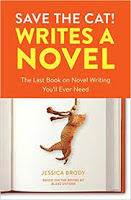 Way back when I worked for a book distributor, Michael Wiese Productions sent me a sample copy of the original
Save the Cat
by Blake Snyder. I devoured that book, and it helped launch my career as a novelist.
Way back when I worked for a book distributor, Michael Wiese Productions sent me a sample copy of the original
Save the Cat
by Blake Snyder. I devoured that book, and it helped launch my career as a novelist. The original Save the Cat! book series was aimed at screenwriters. This brand-new version by Jessica Brody seamlessly adapts Blake Snyder’s methods for novelists. It’s one of the best “how to write a novel” books of the decade.
Get it. Read it. Follow it. You'll be glad you did.
2. The Emotion Thesaurus by Angela Ackerman & Becca Puglisi
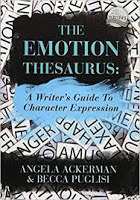 Whenever you or I write the first draft of the story, our characters tend to exhibit the same cliche body language: nodding, shrugging, grinning. Pretty uninspired stuff, really.
Whenever you or I write the first draft of the story, our characters tend to exhibit the same cliche body language: nodding, shrugging, grinning. Pretty uninspired stuff, really. Solution? Crack open this book, which contains more than 150 pages of body language, internal sensations, and mental responses to every imaginable emotion.
Is your character determined? Show him rolling up his sleeves. Is she mortified? Show her covering her face with her hands. Instantly, this book will have your characters winking, swaggering, leaning closer, tapping their feet, tightening their fists -- and coming alive on the page.
While you're getting this book, pick up the rest of the books in this series. Believe me, you'll use them.
3. Writing Screenplays That Sell by Michael Hauge
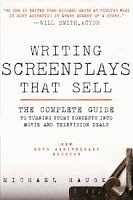 Michael Hauge is a storytelling genius. He’s not only a best-selling author and inspiring speaker, he’s also one of Hollywood’s top story experts. He’s worked on projects starring Will Smith, Julia Roberts, Tom Cruise, Reese Witherspoon, and Morgan Freeman. This book is packed solid with practical, nuts-and-bolts techniques you can use to write a better screenplay, novel, short story, or any work of fiction. It’s no exaggeration to say that reading that book forever transformed the way I look at stories.
Michael Hauge is a storytelling genius. He’s not only a best-selling author and inspiring speaker, he’s also one of Hollywood’s top story experts. He’s worked on projects starring Will Smith, Julia Roberts, Tom Cruise, Reese Witherspoon, and Morgan Freeman. This book is packed solid with practical, nuts-and-bolts techniques you can use to write a better screenplay, novel, short story, or any work of fiction. It’s no exaggeration to say that reading that book forever transformed the way I look at stories.Plus, Hauge is a super, super nice guy. Every time I talk to him, I come away wiser. So check out his books.
4. Scene & Structure by Jack M. Bickham
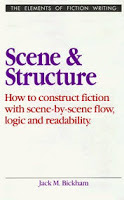 You really should read all of Jack Bickham’s books on writing, but this one in particular. It is packed with masterful techniques to keep readers hooked throughout a story.
You really should read all of Jack Bickham’s books on writing, but this one in particular. It is packed with masterful techniques to keep readers hooked throughout a story. Perhaps the biggest revelation in this book is the way Bickham breaks down cause and effect. Stories are told not just in scenes, but also in something he calls “sequels.” A sequel is a moment (or even a whole chapter) when the lead character emotionally reacts to the previous scene, revisits the big story questions, works through a dilemma, and decides on a new course of action.
If you want to become a successful author, you need to master the scene and sequel technique. This book shows you how.
5. The DC Comics Guide to Writing Comics by Dennis O'Neil
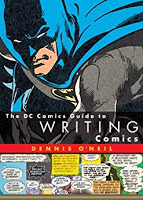 Even if you don't read comic books, you can't deny their enormous impact on popular books, movies, and TV shows today. Best-selling novelist and comic book legend Dennis O'Neil breaks down the elements that make comic book stories work. It's also a fascinating primer on solid storytelling techniques that can benefit any writer.
Even if you don't read comic books, you can't deny their enormous impact on popular books, movies, and TV shows today. Best-selling novelist and comic book legend Dennis O'Neil breaks down the elements that make comic book stories work. It's also a fascinating primer on solid storytelling techniques that can benefit any writer.6. The Complete Writer's Guide to Heroes and Heroines by Tami D. Cowden, Carol LeFever, Sue Viders
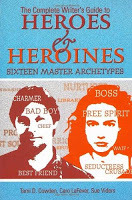 I happened to pick up this book at the Tattered Cover bookstore nearly 20 years ago, and I have never since found a more practical guide to character relationships.
I happened to pick up this book at the Tattered Cover bookstore nearly 20 years ago, and I have never since found a more practical guide to character relationships. Aimed at romance writers (but useful to anyone), this book divides male and female characters into eight broad archetypes. Male types include The Chief, the Bad Boy, the Best Friend, etc. Female types include the Nurturer, the Free Spirit, the Librarian, and so on.
This is not in-depth psychology, here. But it works. Take a look at my Dru Jasper urban fantasy series. I have a Librarian named Dru and a Bad Boy named Greyson. They fall in love. By and large, the critics love them.
The genius of this book is that it shows you how the archetypes interact with each other. For example, how do the Bad Boy and the Librarian drive each other crazy? How do they work together as a team? How do they eventually change each other for the better? Read the book and find out.
What are your favorite writing books?
I'm always on the lookout for new books to add to my shelf. What titles have you found to be especially useful, interesting, or inspiring? Leave me a comment below, or contact me on my author website at www.LaurenceMacNaughton.com.
 Laurence MacNaughton is the author of more than a dozen novels, novellas, and short stories. His work has been praised by Booklist, Publishers Weekly, RT Book Reviews, Library Journal, and Kirkus Reviews. He lives in Colorado with his wife and too many old cars. Try his stories for free at www.laurencemacnaughton.com.
Laurence MacNaughton is the author of more than a dozen novels, novellas, and short stories. His work has been praised by Booklist, Publishers Weekly, RT Book Reviews, Library Journal, and Kirkus Reviews. He lives in Colorado with his wife and too many old cars. Try his stories for free at www.laurencemacnaughton.com.Website | Facebook | Twitter | Goodreads
About No Sleep till Doomsday (Dru Jasper, Book 3)
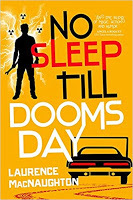 An inexperienced sorceress must retrieve a priceless artifact from the enchantress who stole it, break the curse on her half-demon boyfriend, and stop her friends from turning on each other before the enchantress calls down doomsday.
An inexperienced sorceress must retrieve a priceless artifact from the enchantress who stole it, break the curse on her half-demon boyfriend, and stop her friends from turning on each other before the enchantress calls down doomsday.When a wicked enchantress steals a cursed doomsday amulet, crystal sorceress Dru Jasper has only twenty-four hours to get it back before the world will come to a fiery end. With this supernatural amulet in hand, the enchantress intends to break the sixth seal of the apocalypse scroll--making the seas boil, the stars fall from the sky, and the earth itself split apart. Overall, bad news.
Dru must hit the road to get the amulet back. But she suspects her half-demon boyfriend, Greyson, and his demon-possessed muscle car, Hellbringer, are hiding a dark secret. Can she trust them to help her stop doomsday? Worse, tracking down the enchantress runs Dru smack up against a pack of killer shape-shifters, the grim mystery of a radioactive ghost town, and a dangerous speed demon even more powerful than Hellbringer.
As the clock runs out, Dru is locked in a high-speed chase with the enchantress, fighting a fierce, magical duel she can never win alone. Can Dru and her sorcerer friends unravel Hellbringer's secrets, outwit the shape-shifters, and retrieve the stolen amulet before the dawn of doomsday?
Amazon | Barnes & Noble | iTunes | Indie Bound | Kobo
Written by Janice Hardy. Fiction-University.com

Published on December 11, 2018 03:00
December 10, 2018
Want to Improve Your Writing? Change Your Thinking
 By Janice Hardy, @Janice_Hardy
By Janice Hardy, @Janice_Hardy A mental shift in how we think about our writing and process can change our perspective, and thus, help us see the things we’ve been missing.
A long time ago, when I was still fairly new to writing, I had my mind blown by a simple “change of perspective” in how I looked at writing. It was a light-bub moment that finally made me understand something I’d been struggling with at that time—point of view.
In the years that followed, I’ve had plenty moments where changing how I viewed or thought about something writing-related helped me understand it, or use it better. As I’ve spoken with other writers, I’ve seen the same lights go on in their eyes as they looked at something they’d struggled with and finally saw things click into place.
Continue ReadingWritten by Janice Hardy. Fiction-University.com

Published on December 10, 2018 05:05
December 9, 2018
Writing Prompt: The Free Write: A Deal You Can’t Refuse
 By Janice Hardy, @Janice_Hardy
By Janice Hardy, @Janice_HardyThis week’s prompt is a free write, so take the seed below and run with it. It doesn’t have to turn into anything (unless you want it to, of course), just let the words flow and see where they go.
Take this situation and follow it wherever it goes:
Someone offers your protagonist a deal that gives them their dream, but they have to do something that goes against their principles to get it.
Write as much or as little as you’d like. Written by Janice Hardy. Fiction-University.com

Published on December 09, 2018 04:48
December 8, 2018
Real Life Diagnostics: Does This Scene Make You Want to Keep Reading?
 Critique By Maria D'Marco
Critique By Maria D'Marco Real Life Diagnostics is a weekly column that studies a snippet of a work in progress for specific issues. Readers are encouraged to send in work with questions, and we diagnose it on the site. It’s part critique, part example, and designed to help the submitter as well as anyone else having a similar problem.
If you're interested in submitting to Real Life Diagnostics, please check out these guidelines.
Submissions currently in the queue: One
Please Note: As of today, RLD slots are booked through December 15.
This week’s questions:
1. Does this scene make you want to keep reading?
2. Does it show, not tell?
3. Is there enough information/description to set the scene for the reader?
Market/Genre: Unspecified
On to the diagnosis…
Continue ReadingWritten by Janice Hardy. Fiction-University.com

Published on December 08, 2018 06:00
December 7, 2018
You've Finished NaNoWriMo: Now What?
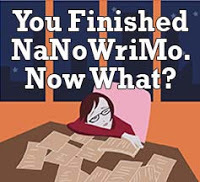 By Janice Hardy, @Janice_Hardy
By Janice Hardy, @Janice_Hardy This week's Refresher Friday is for all those writers who just wrote their hearts out in November and aren't sure what to do next.
A big congratulations to all the NaNo'ers out there who made it through the month. No matter how many words you wrote, rejoice that you dedicated time to writing.
Now that it's over, here are some suggestions on what to do next:
Continue ReadingWritten by Janice Hardy. Fiction-University.com

Published on December 07, 2018 03:00
December 6, 2018
5 Ways to Write Stronger Opening Scenes
 By Janice Hardy, @Janice_Hardy
By Janice Hardy, @Janice_HardyThe opening scene can make or break your novel, so make sure you write a strong one.
There’s a wide range of advice when it comes to writing opening scenes. Many say not to worry about it, because odds are the real opening is several pages (or scenes) into the book and you’ll toss the opening anyway. Others say you won’t really know the right opening scene until you’ve written then ending, and then you’ll go back and rewrite it. Then there are those who can’t write the book until they get the right opening scene, and it won’t need to be changed later.
I agree with all of this, because every writer is different. You might need the “throat clearing” a throwaway opening scene gives you, or you might like to start off strong and build from there. Whatever works for you, works. I’m a “get it right the first time” writer myself and can spend weeks (or longer) just coming up with the perfect opening line.
Continue ReadingWritten by Janice Hardy. Fiction-University.com

Published on December 06, 2018 03:00
December 5, 2018
You CAN Judge a Book by Its Cover
 By Ray Flynt
By Ray FlyntPart of the Indie Author Series
As difficult as it is to write a book, choosing an indie author path requires attending to so many more aspects of the entire publishing experience. Among the most important is creating a book’s cover.
First, I want to recommend a post by J. Kathleen Cheney from this Indie Author’s Series back in February. She addresses various cover design resources.
A few of my thoughts might overlap, but that’s okay since it never hurts to reinforce good ideas.
We caution against clichés in fiction writing, but in forums like this one, their use can be a shorthand way of making a point. You’ve heard the expression: You can’t judge a book by its cover. True, somewhat. But a cover provides a prospective reader with a sense of what the book might be about. It sets a mood. It reflects your degree of professionalism.
Continue ReadingWritten by Janice Hardy. Fiction-University.com

Published on December 05, 2018 04:32
December 4, 2018
Editing After #NaNoWriMo – Make Your #Writing Shine
 By Chris Eboch
By Chris EbochPart of the How They Do It Series
JH: Getting to the end of NaNoWriMo is just the beginning for many writers. After that, it's time to revise those words we raced to get down. Chris Eboch visits the lecture hall today to share some tips on how to make your writing shine post-NaNo.
Chris Eboch is the author of over 60 books for children, including nonfiction and fiction, early reader through teen. Her novels for ages nine and up include The Eyes of Pharaoh , a mystery in ancient Egypt; The Well of Sacrifice , a Mayan adventure; The Genie’s Gift, a middle eastern fantasy; and the Haunted series, about kids who travel with a ghost hunter TV show, which starts with The Ghost on the Stairs .
Learn more at Chris’s website or her Amazon page, or check out her writing tips at her Write Like a Pro! blog. You can also find Chris at B&N/Nook, Kobo, or iBooks, or visit her GoodReads Author Page
Chris also writes for adults under the name Kris Bock. Kris Bock novels are action-packed romantic adventures set in Southwestern landscapes. Fans of Mary Stewart, Barbara Michaels, and Nora Roberts will want to check out Kris Bock’s romantic adventures. “ Counterfeits is the kind of romantic suspense novel I have enjoyed since I first read Mary Stewart’s Moonspinners.” 5 Stars – Roberta at Sensuous Reviews blog
Read excerpts at www.krisbock.com or visit her Amazon page. Sign up for the Kris Bock newsletter for announcements of new books, sales, and more. You can also visit her blog, The Southwest Armchair Traveler, or find Kris Bock on GoodReads, on Facebook, on Twitter, on Pinterest, or on Instagram.
Take it away Chris...
Continue ReadingWritten by Janice Hardy. Fiction-University.com

Published on December 04, 2018 03:30
December 3, 2018
A Faster Way to Write a First Draft
 By Janice Hardy, @Janice_Hardy
By Janice Hardy, @Janice_Hardy Writers are always looking for a way to write faster, and sometimes, writing more means starting out with less.
For this year’s NaNoWriMo, I tried something different to see if I could raise my word count and productivity, and get a finished first draft faster. Since my goal was 80,000 words, I’d started a few weeks earlier than November 1, and planned to finish the first draft by November 30.
In seven weeks, I wrote my 80,000 words, 50,000 of them during NaNo.
What constitutes a “fast first draft” varies by writer, but for me, that’s at least half the time it normally takes me to complete a first draft, and a third of the time for those harder-to-write books. That’s an improvement of 50-66% over my regular drafting process. Writers who already write that fast might be able to shorten their drafting times as well.
Continue ReadingWritten by Janice Hardy. Fiction-University.com

Published on December 03, 2018 05:19



